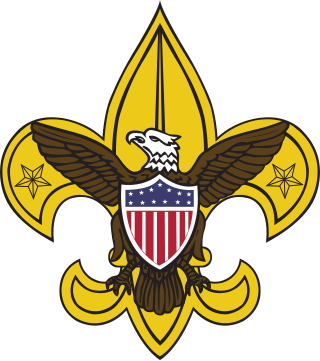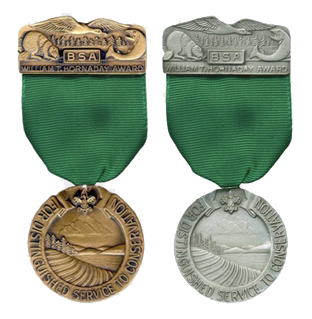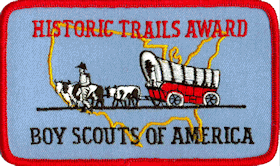
The Boy Scouts of America is one of the largest scouting organizations and one of the largest youth organizations in the United States, with about 762,000 youth participants. The BSA was founded in 1910, and since then, about 110 million Americans have participated in BSA programs. BSA is part of the international Scout Movement and became a founding member organization of the World Organization of the Scout Movement in 1922.

The Order of the Arrow (OA) is the honor society of the Boy Scouts of America (BSA), composed of Scouts and Scouters who best exemplify the Scout Oath and Law in their daily lives as elected by their peers. The society was created by E. Urner Goodman, with the assistance of Carroll A. Edson, in 1915 as a means of reinforcing the Scout Oath and the Scout Law. It uses imagery commonly associated with American Indian cultures for its self-invented ceremonies. These ceremonies are usually for recognition of leadership qualities, camping skills, and other scouting ideals as exemplified by their elected peers.

Eagle Scout is the highest achievement or rank attainable in the Scouts BSA program of the Boy Scouts of America (BSA). Since its inception in 1911, only four percent of Scouts have earned this rank after a lengthy review process. The Eagle Scout rank has been earned by over 2.5 million youth.

Philmont Scout Ranch is a ranch located in Colfax County, New Mexico, near the village of Cimarron; it covers 140,177 acres (56,728 ha) of wilderness in the Sangre de Cristo Mountains on the east side of the Cimarron Range of the Rocky Mountains. Donated by oil baron Waite Phillips, the ranch is owned and operated by the Boy Scouts of America. It is a National High Adventure Base where crews of Scouts and Venturers take part in backpacking treks and other outdoor activities. By land area, it is one of the largest youth camps in the world. During the 2019 season, between June 8 and August 22, an estimated 24,000 Scouts and adult leaders backpacked through the Ranch's extensive backcountry. That same year 1,302 staff were responsible for the Ranch's summer operations.

Advancement and recognition in the Boy Scouts of America is a tradition dating from the inception of the Scouting movement. A fundamental purpose of advancement is the self-confidence a young man or woman acquires from his participation in Scouting. Advancement is one of the methods used in the "Aims and Methods of Scouting"– character development, citizenship training and personal fitness.

Cub Scouting is part of the Scouting program of the Boy Scouts of America (BSA), available to boys and girls from kindergarten through fifth grade, or 5 to 10 years of age and their families. Its membership is the largest of the five main BSA divisions. Cub Scouting is part of the worldwide Scouting movement and aims to promote character development, citizenship training, personal fitness, and leadership.

A variety of religious emblems programs are used by the Boy Scouts of America (BSA) to encourage youth to learn about their faith and to recognize adults who provide significant service to youth in a religious environment. These religious programs are created, administered and awarded by the various religious groups, not the BSA, but each program must be recognized by the BSA.

Varsity Scouting was a program of the Boy Scouts of America (BSA). It was an alternative available to boys ages fourteen to eighteen until the end of 2017. It used the basic Boy Scouting program and added high adventure, sporting, and other elements that were more appealing to older youth to accomplish the aims of character development, citizenship training, and personal fitness. Varsity Scouts were organized into teams; separate chartered units from a Boy Scout troop.

The uniform and insignia of the Boy Scouts of America (BSA) gives a Scout visibility and creates a level of identity within both the unit and the community. The uniform is used to promote equality while showing individual achievement. While all uniforms are similar in basic design, they do vary in color and detail to identify the different membership divisions of Cub Scouting, Scouts BSA and Venturing. Many people collect BSA insignia such as camporee and jamboree emblems, council shoulder strips and historical badges.

The American Heritage Girls (AHG) is a Christian-based Scouting-like organization for Americans. The organization has more than 52,000 members (2020) with troops or individuals ("trailblazers") in all 50 states of the United States and for American expatriates in fifteen other countries.

Scouts BSA is the flagship program and membership level of the Boy Scouts of America (BSA) for boys and girls between the ages of typically 11 and 17. It provides youth training in character, citizenship, and mental and personal fitness. Scouts are expected to develop personal religious values, learn the principles of American heritage and government, and acquire skills to become successful adults.
Cub Scouts is the section of Scouts Australia for boys and girls aged 8 to 11 (inclusive), often known simply as 'Cubs'. The Cub Scout section follows after Joey Scouts and is before Scouts. Cub Scouts wear a uniform shirt with navy blue panels, and yellow shoulders.

The advancement program for Scouts participating in the Scouts BSA program of the Boy Scouts of America is symbolized by the earning of seven ranks. The advancement program is often considered to be divided into two phases. The first phase from joining to First Class is designed to teach the scout Scoutcraft skills, how to participate in a group and to learn self-reliance. The Scout badge is awarded when the Scout demonstrates a rudimentary knowledge of the Scouting ideals and program. Tenderfoot, Second Class, and First Class have progressively harder requirements in the areas of Scoutcraft, physical fitness, citizenship, personal growth and Scout Spirit.
The Eagle Scout Service Project, or simply Eagle Project, is the opportunity for a Scout, or qualified Venturer or Sea Scout in the Boy Scouts of America (B.S.A.) to demonstrate leadership of others while performing a project for the benefit of their community. This is the culmination of the Scout's leadership training, and it requires a significant effort on his or her part. The project must benefit an organization other than the B.S.A., and it cannot be performed for an individual or a business or be commercial in nature. Completing an Eagle Project is a requirement in order for Scouts to attain the Eagle Scout rank.

The William T. Hornaday Awards were a series of awards presented by the Boy Scouts of America for service in conservation and ecology. The program is designed to encourage learning about natural resource conservation and the environment, teach sound stewardship of the natural resources and the environment, and recognize those who are outstanding in this field. Considered to be the highest service award a youth could earn in the Boy Scouts, it was a rare and highly prized medal, with only 1,200 medals being awarded in its more than 100 year history. In an effort to distance itself from the controversial history of Dr. Hornaday, the Boy Scouts of America formally retired the William T. Hornaday awards in October of 2020, creating the Distinguished Conservation Service Award in its place.

The Historic Trails Award is an award of the Boy Scouts of America (BSA) designed to promote the ideals of Scouting and in Scoutcraft, citizenship, self-reliance, and appreciation of national history. It is awarded for studying about, hiking or camping along, and performing a service project on a historic trail. The award may be earned by Cub Scouts, Boy Scouts, Sea Scouts, Venturers and leaders.
The Scouter's Training Award is an adult recognition of the Boy Scouts of America. This award is available across several different program areas and can be earned more than once.
The Scouter's Key Award is an adult recognition of the Boy Scouts of America. This award is available across several different program areas and can be earned more than once.

The Venturing Summit is the highest rank for youth in the Venturing program of the Boy Scouts of America. It requires Venturers to earn the Pathfinder Rank, participate in adventures, and demonstrate leadership, service and personal growth.
The emblem of the International Spirit Award is worn as a temporary patch by both youth and adult leaders in the Boy Scouts of America. The award recognizes those who have broadened their knowledge of international Scouting and increased their appreciation and awareness of different cultures and countries. This award replaces the International Activity Patch (1991-2012).
















